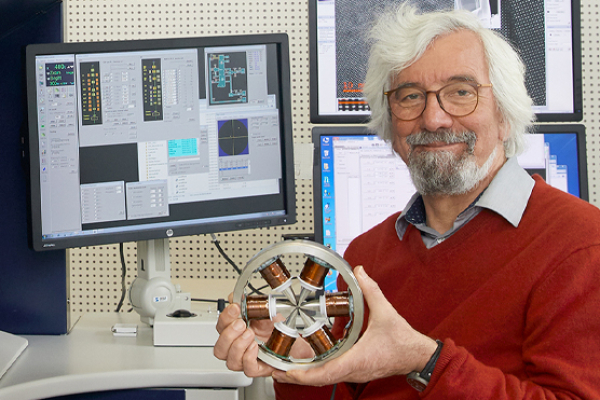Maximilian Haider: Finalist for the European Inventor Award 2019

Maximilian Haider of the CEOS has been selected as a finalist for the European Inventor Award within the category Lifetime Achievement for his invention: Sharper electron microscopes
Austrian physicist Maximilian Haider improved the image resolution of electron microscopes by over five times, solving a 60-year-old scientific puzzle and revealing single atoms for scientific scrutiny. The electromagnetic corrective lens that he patented is now used in 90% of transmission electron microscopes worldwide.
Modern electronics requires components so small that scientists cannot resolve their features under optical microscopes. Electron microscopes can image finer levels of detail using beams of charged electrons instead of light. For a long time, inherent distortions inside these instruments limited their resolution, restricting the precision of the work being carried out. Physicists had long proposed theoretical solutions to correct deformations in the particle beams and reveal materials with atomic resolution, but for 60 years no one had managed to implement these ideas into a working device.
In the 1990s, Maximilian Haider joined forces with physicist Harald Rose and material scientist Kurt Urban to correct the blur in electron microscopes. Rose had convinced Haider to pursue a PhD in electron microscopy and together with Urban they worked on potential solutions to electron beam distortion. Upon completing his PhD, Haider continued to build upon his existing research in the field. He developed and incorporated a set of magnetic pole-pieces (known as hexapoles and lenses) inside an electron microscope. The pieces he incorporated cancelled out distortions that arise within charged particle beams on their way from the sample to the detector. In 1996, Haider, Rose and physicist Joachim Zach co-founded a company (CEOS) to commercialise the invention. By the following year, the technology was finally operational, achieving a record electron microscope resolution of 0.12 nanometres.. This advancement brought into focus materials and electronic components in unprecedented detail, even revealing single molecules and atoms within crystals. In 2015, Haider's work paved the way to achieving a new world-record resolution of 0.043 nanometres, which is shorter than the radius of a hydrogen-atom.
Haider had filed a patent application for his invention in 1998. Since then, his electromagnetic corrector has been used in the majority of transmission electron microscopes on the market. The invention is helping microchip manufacturers miniaturise electronic components at the heart of laptop computers and smart phones. Unprecedented image resolutions are also backing progress in solar cells, batteries, biotechnology and the oil and gas sector. CEOS, the company he co-founded, has grown to 47 employees and now reports over EUR 1 million in annual profit.
Born in Freistadt, Austria, in 1950, Haider worked in his teens as an apprentice with opticians in Linz and Cologne. He returned to formal education as an adult and finished high school at the age of 26 before enrolling at the University of Kiel, where he studied physics. He later received his PhD from TU Darmstadt, the university where he worked with theoretical physicist Harald Rose. Following years of technically daunting and at times financially precarious progress, Haider took theoretical solutions from the chalkboard and put them into practice. Today he works as Professor in Electron Optics at Karlsruhe Institute of Technology in Germany, and as a Senior Advisor at CEOS.
